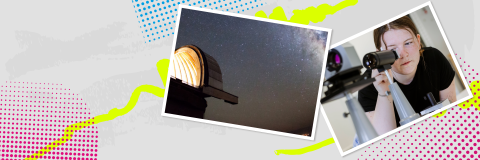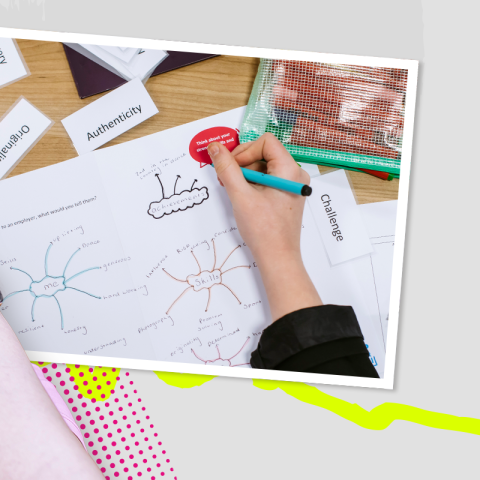

Cosmology and Astrophysics
Understanding the origins of the universe
Have you ever wondered what a galaxy is? Or what was the Big Bang? Is it possible that life might exist on other planets?
These are some of the big questions that you could help researchers from our Institute of Cosmology and Gravitation try to answer. Astronomers take the laws of physics that work here on Earth, and use them to understand more about stars, galaxies and even the entire Universe.
Careers in Cosmology
Cosmology combines both Physics and Astrophysics to explore ideas and theories about how the Universe formed and how it has developed over time. If you’re curious about the world we live in, fascinated by all the possibilities of the universe, and have an interest in Physics, a career in Cosmology might be for you.
Students who choose to study Astrophysics or Cosmology will deepen their understanding of the laws of Physics and use this to understand more about some of the biggest and smallest elements in existence.
Cosmology students work in industries such as:
- Astronomy and theoretical physics
- Space systems and aerospace industry
- Education
- Scientific journalism
- Medical physics
- Data analysis
What jobs can you do with a Cosmology and Astrophysics degree?
Careers in astronomy, cosmology and physics are truly diverse. From roles such as planetary geologists, astrobiologists, cosmologists and telescope design engineers. To academic research, earth sciences and software development.
You'll develop your skills in things like physics, mathematics, statistics and computer programming. And in this field, your passion for problem-solving will help you traverse through many industries and maybe even all corners of the Universe.
Explore the study of light and spectra
Astrophysicists and cosmologists use the study of light and spectra to look at distant stars, planets and galaxies.
They may be researching the temperature or density of an element in a star, or studying the properties of the material interacting with things in space. Here, you'll discover how they use light and spectra, and some of the things you might do in your future career in the field.
Learn more about the visible light spectrum, refraction and diffraction
Light and Spectra
This short video provides an overview of the light spectrum and a simple way to view light spectra in your own home.
Today, we're going to be talking a lot about light.
So the first thing to know is that light acts as a wave.
A wave has speed.
How fast it travels.
A wave length.
How long each full wave is and frequency.
How often it completes one wave.
Each wave length of visible light corresponds to a different colour.
Red light has the longest wave length and violet light has the shortest wavelength and all the other colours fit in between.
All these colours have a wavelength between 400 and 700 nanometres.
The other thing we talk a lot about is Spectra.
The visible spectrum is a band of all the colours of visible light ordered by their wavelength.
White light is a combination of all of these colours.
And it is possible to split white light up to see the visible colour spectrum.
An example like being split up is in a rainbow.
A rainbow happens due to an effect known as refraction.
Let's look at the longer wavelength, red and shorter wavelength, blue light.
When light enters a different medium, it slows down.
The shorter wavelength blue light slows down more than the longer wavelength red light.
The slowing of the light causes it to change direction.
As the blue light slows down more, it also changes direction more.
This effect means that when white light enters a medium in this way, each colour within the white light changes by a slightly different angle and therefore the spectrum spreads out.
In a raindrop, white light enters at an angle, the light slows and changes direction, and the colours start separate like we've just seen.
The light reflects off the back of the droplet and continues to move apart.
By the point where it leaves the droplet, we have a fully split up spectrum of light, which we can then see as a rainbow.
Today for making our own spectroscopes, we're going to use a different method of splitting up light called diffraction.
When a plane wave, like a wave on the sea, passes through a small gap, it starts to spread out into a semicircular wave.
Now, if a wave passes between more than one small gap, you get a semicircular wave like this spreading out from each gap.
These waves can then interfere with each other.
This means where they meet, they combine.
You can see that at some points the lines cross.
If the peaks of two waves meet and combine, we get a larger amplitude wave and we call this constructive interference.
If a peak and a trough meet, they will cancel out and we call this destructive interference.
The dots are showing all the points of constructive interference.
If we follow the path of these constructive points, we find bright interference lines.
Where destructive interference occurred, we see dark lines.
We call this an interference pattern.
Because of the difference in wavelength, which on this diagram would be the distance between the lines, blue and red light will interfere constructively at slightly different places.
This means that in our interference pattern, we will get a rainbow with blue closest to the middle and red, furthest from the middle, either side of the centre line.
This effect doesn't just happen when passing through a gap, light also behave this way when it reflects off a surface with many narrow grooves, like a CD.
This is why when you look at CD, it looks colourful.
We're going to use the way CDs diffract light to create our own scope, which can split up colours for us.
In a similar way to how you'll have seen different spectra from different light sources, different objects in space have different spectra as well. This is usually to do with the chemical elements that they are made from.
This next video explains more about why we see different spectra and how they are used by Astronomers to identify whether there may be life on other planets or asteroids in space.
Using Spectra in Astronomy
How can spectra be used?
Dr Jen Gupta demonstrates how Spectra is used in Astronomy, and asks how it can be used to determine the likelihood of life on distant planets.
In this video, we're going to talk about using spectra in astronomy and what looking at rainbows using a CD has to do with space.
Hopefully you've managed to see some spectra using your CD spectroscope.
If you took photos of them, don't forget to submit them to us because we'd love to see the results.
I had a go at home too, looking at sunlight safely on a cloudy day through my conservatory roof, my TV, and an energy saving light bulb.
You can see that we got a pretty full spectrum from the sun, while my TV shows red, green and blue because of the filters used to make the display.
With the energy saving light bulb, we clearly have some bright lines and then some parts missing.
So what are we seeing here and what does this have to do with astronomy? The bright lines we see in the light bulb spectrum depend on the chemical elements that are present in the bulb.
What this ultimately means is that we can find out what objects in space are made of just from the light they emit.
Let's look at how this works.
Here's an electron in a hydrogen atom.
Electrons in an atom have energy levels.
This one is in energy level or n = 2.
Sometimes something causes the electron to gain some energy.
For instance, the atom it's a part of colliding with another atom.
When it gains energy, the electron moves up into a higher energy state.
But as soon as it can, it will release this energy in the form of a photon and drop back down to a lower energy level.
This photon's wavelength and therefore colour will depend on how much energy the electron released.
In this example, we see the electron releasing red, aqua and blue light from the three transitions.
This particular example happened in hydrogen.
So when we look at the light coming from hydrogen, we don't see the full visible spectrum, but these specific bright lines.
You can see that the electron can move up and down the energy levels, but it can't be in between.
The difference in these energy levels depends on how strongly the electron is attracted to the nucleus, which depends on how many protons there are.
Each element has a different number of protons.
This means that the energy levels in each element will be slightly different and therefore the colours released will also be different.
It's like each element having a fingerprint.
It's spectrum, like a fingerprint, is unique and not shared by any other element.
This is why spectra are so important to astronomers.
If we can see the spectrum of objects in space, then we can match it up to the spectra of different elements we know here on Earth and work out what the object is made of.
This is exactly what astronomers do with clouds of gas in space, like the Orion Nebula.
The gas gets heated up by the young stars inside the nebula, which gives energy to the electrons and the atom, which then results in an emission spectrum like we showed earlier.
But that's not all.
While we've been looking at the emission spectra so far, there is also something called an absorbtion spectrum which works the other way around.
This is when we see the effects of the electron absorbing photons of certain wavelengths that allow them to make that jump up in energy levels.
So if, for example, you have white light coming from the centre of a star and travelling through the gas in its outer layers, the spectrum that we see will have dark lines where the wavelengths are being absorbed and are missing from the full visible spectrum.
You can see a comparison of an absorption and emission spectrum here.
We have the same lines, but in one they're the only light and in the other they are the only dark parts.
One use for this method is looking at planets, we can already work out what the gas planets in our solar system like Jupiter and Saturn are made of by looking at the absorption spectrum of sunlight reflecting off them.
If a distant planet passes in front of it's star while we are observing it, we could in theory see the absorption spectrum from the starlight travelling through that planet's atmosphere and then work out if it will be possible for life to exist on that planet.
Your second challenge for this session is to look at two different absorption spectra and work out which elements are present.
Once you've done that, you can then decide which planet is more likely to have life on it.
Good luck.
How are ICG researchers using spectra to understand the Universe?
In the previous activity, you’ve seen just one of the many ways that astronomers can use spectra to study distant objects and learn more about the Universe.
Take a look at some of the other ways that researchers at our Institute of Cosmology and Gravitation are using spectra in their work.
To study super massive black holes:
Dr Becky Canning studies the spectra from the gas surrounding super massive black holes and the galaxies which contain them. Using these spectra, Becky wants to understand how these black holes affect the galaxies that host them, as well as the environments these galaxies live in.
To understand how galaxies evolve:
Professor Daniel Thomas uses the spectra of galaxies to study their chemical elements and the particular populations of stars contained within different galaxy types. He is using a methodology very similar to what archaeologists do by estimating the ages of galaxies from the ratio of chemical elements. Daniel’s research helps astronomers better understand how galaxies form and evolve over time.
To use gas to map the structure of the Universe
Professor David Bacon is figuring out how to use the spectra of the hydrogen gas in and around distant galaxies in radio wavelengths. By detecting and mapping the position of this gas, David will be a member of a science team providing a picture of the large-scale web-like structure formed by groups of galaxies in the Universe.




